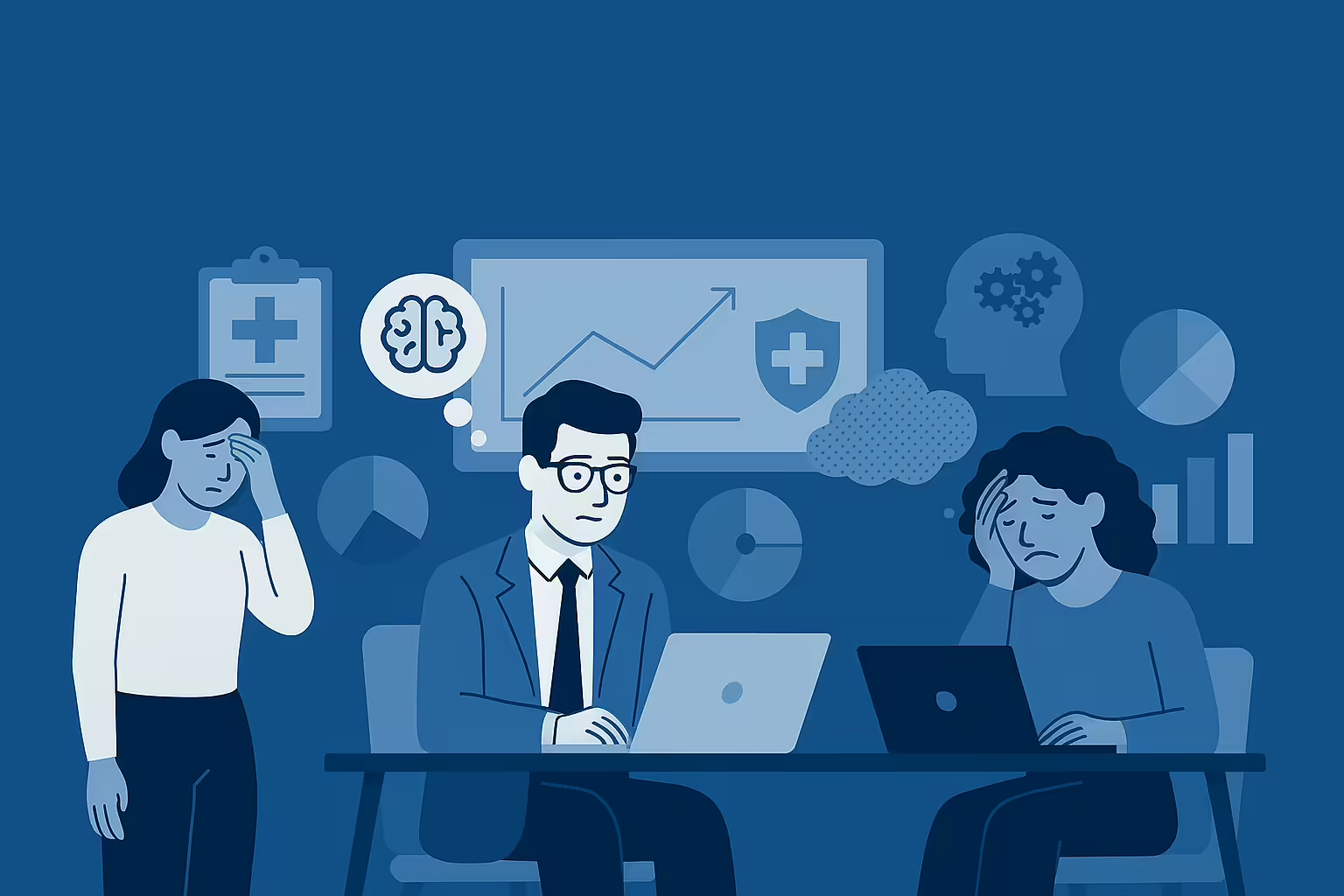Workforce wellbeing in SMEs 2025. As England’s workforce navigates the complexities of 2025, the CIPD’s latest Health and Wellbeing at Work report offers a crucial lens into the evolving landscape of employee health, absence, and wellbeing. Drawing on survey responses from over 1,100 HR and management professionals, the report provides a detailed snapshot of the challenges and opportunities facing organisations—especially SMEs—as they strive to support their people in a rapidly changing world.
Key Findings: A Sharp Rise in Sickness Absence
One of the most striking revelations is the sharp increase in sickness absence. The average number of days lost per employee per year has surged to 9.4 days, up from 7.8 in 2023 and 5.8 in 2022. This marks another record high and signals a worrying trend for employers and policymakers alike.
Mental ill health is now the top cause of long-term absence, cited by 41% of respondents as one of the top three causes. Minor illnesses remain the main reason for short-term absence (78%), but mental ill health is also the second main cause of short-term absence (29%), with stress a major contributor to both short- and long-term sickness absence (26% and 28%, respectively).
Sector and Size: SMEs vs Larger Organisations
Absence rates have increased across all sectors, but the public sector continues to report the highest levels. However, the data reveals that smaller organisations (SMEs) tend to have lower absence rates than larger businesses. For example, organisations with fewer than 50 employees report an average of 4.5 days lost per employee per year, compared to 13.2 days in organisations with 50–249 employees, and 10.9 days in those with 250–999 employees.
This difference may reflect the closer-knit nature of SMEs, where absence is more visible and potentially easier to manage, but it also highlights resource constraints—smaller businesses may lack the capacity to offer extensive wellbeing support, making each absence more impactful.
The Mental Health Challenge: Long-Term Sickness and Its Drivers
The report underscores the growing impact of mental health on workforce absence. Mental ill health is not only the leading cause of long-term absence but is increasingly cited as a reason for short-term absence as well. Stress is the fourth most common cause of both short- and long-term absence, with public sector and larger private sector organisations particularly affected.
What’s driving this trend?
- Heavy workloads are identified as the top cause of stress-related absence (41% of organisations reporting stress-related absence).
- The ageing workforce means more employees are living and working longer, increasing the prevalence of chronic health conditions and disabilities.
- Societal factors, such as economic pressures and the lingering effects of the pandemic, continue to shape the health landscape.
According to the Office for National Statistics (ONS), in 2024, over 8 million people aged 16–64 reported a long-term health condition that limited the type or amount of work they could do. Additionally, 1 in 6 workers in the UK reported experiencing symptoms
Presenteeism: Why Are Employees Working When Unwell?
Presenteeism—working while unwell—remains a significant issue. Over a third (35%) of organisations report that presenteeism has risen as a result of employees working from home. While homeworking has helped reduce sickness absence rates for some (36% report a decrease), it has also blurred the boundaries between work and health, making it easier for employees to “power through” illness rather than take time off.
What’s driving high presenteeism?
- Remote work: The shift to homeworking means employees may feel less able to disconnect, especially if their illness is not immediately visible to managers.
- Work culture: In SMEs, where teams are smaller and workloads may be shared, employees may feel pressure not to let colleagues down.
- Economic pressures: Rising costs and concerns about job security may lead employees to work while unwell, fearing absence could impact their role or income.
The AI Factor: A Double-Edged Sword
As artificial intelligence becomes increasingly embedded in workplace operations, its impact on employee wellbeing is beginning to show—both positively and negatively.
Positive Impacts
- Automation of repetitive tasks can reduce cognitive load and free up time for more meaningful work, potentially lowering stress levels.
- AI-powered wellbeing tools, such as mental health chatbots and predictive analytics, can help identify early signs of burnout and prompt timely interventions.
- Flexible scheduling and workload balancing algorithms can help SMEs manage resources more efficiently, reducing pressure on individual employees.
Negative Impacts
- Job insecurity is a growing concern, particularly in SMEs where roles may be more vulnerable to automation. This uncertainty can contribute to anxiety and stress.
- Surveillance technologies powered by AI—such as productivity tracking software—can lead to feelings of being constantly monitored, which may erode trust and increase mental strain.
- Digital overload from AI-driven communication tools can blur work-life boundaries, especially in remote settings, exacerbating presenteeism and reducing recovery time.
A recent study by the Mental Health Foundation found that 42% of UK employees felt that digital technologies, including AI, had increased their stress levels at work. Meanwhile, 58% believed that AI could be beneficial if used to support—not replace—human decision-making in wellbeing initiatives.
Occupational Health: A Reactive Tool in Need of Strategic Use
The report highlights a concerning trend: occupational health (OH) services are being used more reactively than proactively. While 69% of organisations offer OH services, only 31% use them to manage health risks, and just 29% involve OH in developing health and wellbeing strategies.
In SMEs, access to OH services is even more limited—only 39% provide it. This underutilisation means many organisations are missing out on the preventative potential of OH, such as early intervention, ergonomic assessments, and stress audits. Instead, OH is often reserved for managing complex cases or long-term sickness absence, rather than helping to prevent them.
For SMEs, integrating OH expertise into strategic planning could be a game-changer. Even outsourced services can be leveraged to identify health risks early and support sustainable workforce health.
Management Training: The Confidence Gap in Mental Health Support
Managers play a pivotal role in supporting employee wellbeing, yet the report reveals a significant confidence gap. Only 29% of organisations provide training for managers to support staff with mental ill health. Those that do report markedly better outcomes—73% say their managers are confident to have sensitive discussions and signpost staff to expert help, compared to just 57% in organisations without training.
This lack of preparedness can have serious consequences. Without the skills to recognise early warning signs or conduct supportive conversations, managers may inadvertently contribute to stress or fail to intervene when needed.
For SMEs, where managers often wear multiple hats, targeted training can empower them to support their teams more effectively. Even basic mental health awareness and communication skills can foster a more open, supportive culture.
Interpreting the Data: What Does This Mean for SMEs?
For SMEs, the data presents both challenges and opportunities. While absence rates are generally lower than in larger organisations, the impact of each absence is magnified. SMEs may lack the resources to offer comprehensive wellbeing programmes, but they can leverage their agility and close relationships to foster a supportive culture.
Key insights for SMEs:
- Mental health support is critical: With mental ill health driving long-term absence, SMEs must prioritise mental health interventions, even if resources are limited. Simple measures—like regular check-ins, flexible working, and access to counselling—can make a significant difference.
- Presenteeism needs addressing: Encouraging employees to take time off when needed, and creating a culture where health is valued over “toughing it out,” is essential.
- AI should be used thoughtfully: SMEs should embrace AI where it enhances wellbeing—such as automating admin tasks or offering digital health support—but avoid using it in ways that increase surveillance or stress.



